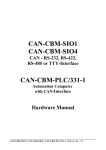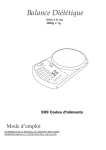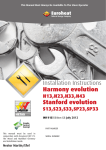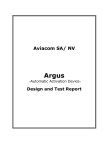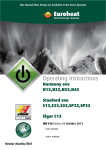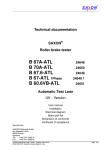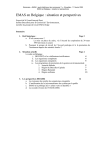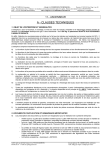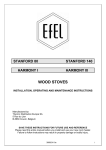Download Euroheat Harmony 1 Technical data
Transcript
Installation & Servicing Harmony I Gas Stove Harmony 1 Gas 49892 EFEL Euroheat Distributors (H.B.S.) Ltd., Unit 2, Court Farm Business Park, Bishops Frome, Worcestershire, WR6 5AY. Thermic Distribution Europe SA, B-5660 Frasnes-lezCouvin, Belgium. © EUROHEAT DISTRIBUTORS (H.B.S) LTD. Aug 2006 1 E & OE nstructions Part number IN1024 Ed H Contents Manufacturers Identification Plate..........................................................................3 Safety Precautions....................................................................................................3 Technical Data...........................................................................................................4 Dimensions................................................................................................................5 Optional decorative plinth........................................................................................5 Primary Air Collar......................................................................................................5 Appliance Location...................................................................................................6 Hearth and Fireplace Requirements........................................................................6 Minimum installation clearances.............................................................................7 Flue and Chimney Requirements............................................................................8 Ventilation..................................................................................................................8 Installation of the Stove to the Flue System...........................................................9 Flue Outlet Direction.................................................................................................9 Installation of the Gas Supply up to the Stove.......................................................9 Gas Connection to the Stove.................................................................................10 Fitting the Coal Effect Kit and Fuel Guard............................................................10 Coal Kit Layout........................................................................................................11 Thermostatic Gas Valve Controls..........................................................................12 Lighting....................................................................................................................12 Commissioning.......................................................................................................13 Gas valve components and adjustment screws..................................................14 Users Manual...........................................................................................................15 Pilot assembly.........................................................................................................15 Servicing Instructions............................................................................................16 Annual Service........................................................................................................16 Changing Gas Operating Type...............................................................................17 Removal of Gas Burner and Access to Air Collar................................................17 Main Burner Jet Replacement................................................................................18 Accessing Gas Valve and Thermocouple TTB.....................................................18 Ignition Battery Replacement................................................................................18 Replacing Gas Valves Eurosit 630 Thermostatic and Manual............................19 Service Record........................................................................................................20 Technical Help Line User information 01885 491100 For installation service advice for installers and service engineers 8.30am - 5.30pm Week days Telephone 01885 491117 Fax 01885 491101 anytime. © EUROHEAT DISTRIBUTORS (H.B.S) LTD. Aug 2006 Email [email protected] For the latest Technical and operating advice visit the Euroheat web site. www.euroheat.co.uk 2 E & OE Instructions Part number IN1024 Ed H Safety Precautions a) The stove should be visually inspected and if damaged should not be installed. b) It is a requirement of the Gas Safety (Installation and Use) Regulations that these instructions, together with the Appliance User Instructions, be left intact with the user. c) In your own interest, and those of safety, and in accordance with the Gas Safety (Installation and Use) Regulations, Efel stoves must be installed by a suitably qualified gas technician using the appropriate fittings for the gas type being used and the stove must not be modified in anyway. The gas technician will be responsible for the installation conforming to all current regulations and standards. Failure to install the appliance correctly could lead to prosecution. d) It is important to ensure that the flue system onto which the appliance is to be installed is working properly. Products of combustion which enter a room could be a serious health risk. It is therefore important, in the interests of safety, that these instructions are strictly followed, together with the legal Statutes and Codes of Practice and current Building Regulations. e) It is important that the stove is installed so that the clearances specified in these instructions are complied with. f) Fireguards, in accordance with current British Standards, should be fitted when the appliance is used in the presence of young children, the elderly or infirm. g) The stove must not be run with its door open. h) It is also important that the occupiers of the property have their attention drawn to the high temperatures which are normally present on the external surfaces of the stove during operation. i) Do not use the stove if any of the ceramic coal components are damaged or broken. j) The plastic bags used to protect components of this appliance are a potential hazard to young children, and should be disposed of immediately. k) The stove must be serviced annually by a suitably qualified gas technician. The Euroheat Appliance Serial Number The serial number is recorded at five locations: 1: On the front page of this manual. 2: On the front page of the operating instructions. 3: On the back of the stove. 4: On the warranty registration form. 5: On the warranty certificate returned to the user after successful registration. Manufacturers Identification Plate The identification plate is on the back of the stove. © EUROHEAT DISTRIBUTORS (H.B.S) LTD. Aug 2006 3 E & OE nstructions Part number IN1024 Ed H Technical Data with Eurosit Gas Valve 630 Heat Output Maximum Heat Output Minimum Gas Input Maximum Gas Input Minimum Heat Control Fuel Types 2 49892 Efficiency Ignition Type Pilot Flame Flame Failure Flue Spillage Sensor Fuel Effect Type Fuel Outlet Options Flue Size Free air requirement 7.1 kW/hr (24225 BTU) 2.8 kW/hr (9553 BTU) 8.6 kW/hr (29343 BTU) 3.79 kW/hr (12700 BTU) Thermostatic and Manual Natural Gas or L. P. G. (specify at time of order) 82% + (net) Battery Spark Yes Yes Thermocouple Interrupter (TTB) Coal Top or Rear (Top pre fitted) 4” (101mm) Internal Diameter 880sq mm Warranty Standard 1 Year Colour Options Cast Black, Satin Black Enamel, Bottle Green Enamel Optional Extra Decorative Plinth 4 6 Harmony I Gas Conventional Flue Model Number A range of vitreous enamelled flue pipe, in Satin Black or Bottle Green, is available from your Euroheat stockist. Gas Type G20 Natural Gas G31 Propane System Main Pressure B u r n e r Nozzle 20mbar 1 jet 4 x 1.20 37mbar 1 jet 4 x 0.73 Nominal Output (Maximum operation) Minimum Output (low operation) Pilot Low N o z z l e Operation size By Pass Heat Output Gas Input Hourly input Burner operating pressure Hourly input Burner operating pressure 0.908 m³/h 13.7mbar 0.33 m³/h 2.5mbar 37 1.70 7kW/hr 23884 BTU/hr 8.6kW/ hr 29343 BTU/hr 0.694kg 30.7mbar 0.295kg 5.9mbar 20 1.11 7kW/hr 23884 BTU/hr 8.6kW/ hr 29343 BTU/hr Seasonal Efficiency The efficiency of this appliance has been measured as specified in BS EN 613:213 and the result is 73.9% Nat Gas and 75.5% LPG. The gross calorific value of the fuel has been used for this efficiency calculation. The test data from which it has been calculated has been certified by BELTEST. The efficiency value may be used in the Governments Standard Assessment Procedure (SAP) for energy rating of dwellings. © EUROHEAT DISTRIBUTORS (H.B.S) LTD. Aug 2006 4 E & OE Instructions Part number IN1024 Ed H Technical Data with Mertik Maxitrol GV34 Gas Valve 49892 Cast Black, Satin Black Enamel, Bottle Green Enamel Optional Extra 3 Decorative Plinth OFF Colour Options N IG Standard 1 Year ON Warranty 1 Efficiency Ignition Type Pilot Flame Flame Failure Flue Spillage Sensor Fuel Effect Type Fuel Outlet Options Flue Size Free air requirement 7.1 kW/hr (24225 BTU) 2.8 kW/hr (9553 BTU) 8.6 kW/hr (29343 BTU) 3.79 kW/hr (12700 BTU) Thermostatic and Manual Natural Gas or L. P. G. (specify at time of order) 82% + (net) Battery Spark Yes Yes Thermocouple Interrupter (TTB) Coal Top or Rear (Top pre fitted) 4” (101mm) Internal Diameter 880sq mm 4 6 Heat Output Maximum Heat Output Minimum Gas Input Maximum Gas Input Minimum Heat Control Fuel Types PILO T 5 Harmony I Gas Conventional Flue Model Number 2 A range of vitreous enamelled flue pipe, in Satin Black or Bottle Green, is available from your Euroheat stockist. Gas Type G20 Natural Gas G31 Propane System Main Pressure B u r n e r Nozzle 20mbar 1 jet 4 x 1.20 37mbar 1 jet 4 x 0.73 Nominal Output (Maximum operation) Minimum Output (low operation) Pilot Nozzle size Heat Output Gas Input Hourly input Burner operating pressure Hourly input Burner operating pressure 0.908 m³/h 13.7mbar 0.33 m³/h 2.5mbar 37 7kW/hr 23884 BTU/hr 8.6kW/ hr 29343 BTU/hr 0.694kg 30.7mbar 0.295kg 5.9mbar 20 7kW/hr 23884 BTU/hr 8.6kW/ hr 29343 BTU/hr Seasonal Efficiency The efficiency of this appliance has been measured as specified in BS EN 613:213 and the result is 73.9% Nat Gas and 75.5% LPG. The gross calorific value of the fuel has been used for this efficiency calculation. The test data from which it has been calculated has been certified by BELTEST. The efficiency value may be used in the Governments Standard Assessment Procedure (SAP) for energy rating of dwellings. E & OE nstructions Part number IN1024 Ed H © EUROHEAT DISTRIBUTORS (H.B.S) LTD. Aug 2006 5 Primary Air Collar Natural Gas The air collar should be adjusted to give a 3 mm wide opening. L.P.G The air collar should be adjusted to give a 5mm wide opening. 3mm 5mm Dimensions 605mm 455mm 420mm 101 ID 101 OD 670mm 525mm 1/2” BSP 45mm 200mm Optional decorative plinth 500mm 650mm © EUROHEAT DISTRIBUTORS (H.B.S) LTD. Aug 2006 6 E & OE Instructions Part number IN1024 Ed H Appliance Location a) This stove must be mounted on a non combustible hearth. The hearth must have a minimum of 12mm non combustible material thickness. The stove can be placed on a wooden floor if it can support the weight and is stable enough that the stove does not move, and as long as the optional decorative cast iron hearth plinth is utilized. b) Combustible material at the rear of the stove shall be protected against the effects of heat transmission. c) There must be a minimum of 300mm from the top of the stove to the underside of any combustible shelf. Note that for every 50mm increase on clearance, the shelf may project by a further 50mm. This measurement may be reduced if the underside of the shelf is protected from the heat from the stove. In all installations surrounding inflammable materials must not exceed 80ºC. d) The appliance must not be installed in a room or space which contains a bath or shower, or in a room used or intended to be used as sleeping accommodation. e) Any manufactured surround used with this stove should comply with the appropriate British Standard. f) Do not place furniture, furnishing or combustible objects within 1 metre of the stove. If any of these conditions are not fulfilled, DO NOT FIT THE STOVE until the problem has been rectified. Hearth and Fireplace Requirements Do not be tempted to fit the stove into an unsuitable fireplace. Beyond the requirements of the Building Regulations and access to facilitate servicing the stove, providing a setting which will complement the Harmony is not a luxury, it is the practicality of making the most of an investment. A good builder will be able to transform even the most utilitarian of fireplaces, whether altering its proportions to those of the “Golden Mean” ideal, exposing a wooden lintel, stone or simply removing superfluous detailing for comparatively small costs, and the result will be a pleasure for many years. Golden Mean 1 2/3 2/3 1/3 2/3 © EUROHEAT DISTRIBUTORS (H.B.S) LTD. Aug 2006 7 E & OE nstructions Part number IN1024 Ed H Minimum installation clearances A B E D F C The measurements are for advice only. In all installations surrounding inflammable materials must not exceed 80ºC. The stove must always stand perfectly level and have sufficient space allowed for service work. Minimum clearance from combustable materials Minimum clearance from non inflammable materials A 12" 300mm 9" 230mm B 12" 300mm 6" 150mm C 0 if stove is fitted with hearth plate otherwise 2” 50mm See Hearth Section D 2" 50mm 2" 50mm E 12" 300mm 6" 150mm F = Decorative Hearth Plinth supplied as optional extra © EUROHEAT DISTRIBUTORS (H.B.S) LTD. Aug 2006 8 E & OE Instructions Part number IN1024 Ed H Flue and Chimney Requirements Before installation of the appliance, the chimney or flue system must be inspected and passed as suitable. In particular, the following should be checked: a) This appliance is suitable for installation onto the following flue types: A suitable sized diameter flexible or fabricated steel flue system, or a purpose built flue lining system. The cross-sectional area of the flue must not be less than the stoves flue connection (see appliance data for flue size). NOTE: Any steel flue systems used should be manufactured to meet with the requirements of British Standards or any other relevant standards, and installed with due regard to the manufacturers recommendations. b) The minimum effective height of the chimney or flue must be 10ft (3 metres) measured from the bottom of the flue spigot to the termination of the flue (chimney pot). If the flue has any non vertical sections the height should be increased in line with current British Standards. c) The chimney or flue must be free from any obstruction. Any flue damper or restrictor must be removed or permanently fixed in the fully open position. d) The chimney should be swept prior to installation of the stove if it has previously been used by an appliance burning any fuel other than gas. However, if the flue is clean and unobstructed throughout its entire length, it need not be swept. e) Ensure that only one fireplace is served by the chimney or flue system. f) Ensure that the chimney or flue system is continuous from inlet to termination. g) Although the current regulations specify a vertical flue, for the required length, from either the top or rear flue options. This stove is capable of working satisfactorily with a 45° bend fitted directly onto the top or rear flue outlet. This bend must be counted in the total bends allowed in a flue system, as specified in the current regulations. There should be no more than one meter of flue pipe between this 45° bend and a second 45° bend to return it to the vertical. h) If the flue is to be connected to the rear flue outlet there should be no more than 150mm of horizontal run before the flue rises vertically. i) Bends must not exceed the angles of those specified in current regulations and standards. j) A suitable flue terminal must be fitted conforming to current British Standards and regulations. NOTE: A guide published by the ‘British Flue and Chimney Manufacturers’ Association’ which contains general information on chimneys and flues can be obtained from: Sterling House, 6, Furlong, Bourne End, Bucks, SL8 5DG. Ventilation The following ventilation requirements must be satisfied. a) If the stove is installed in a builder’s opening or fireplace recess that has an air supply entering this opening or recess from below floor level, this must be completely sealed off. b) If there is another gas appliance fitted in the same room, or adjacent area, or extractor fan system, air conditioning, etc., it will be necessary to refer to current British Standards to ascertain the additional precautions necessary. c) The correct amount of Free Air ventilation must be installed in accordance to current British Standards and regulations (see appliance technical data for Free Air requirement). If any of the pre-installation checks reveal inadequacies, they must be rectified. E & OE nstructions Part number IN1024 Ed H © EUROHEAT DISTRIBUTORS (H.B.S) LTD. Aug 2006 9 Installation of the Stove to the Flue System Flue Outlet Direction Top Flue Option Fit rear section of top flue, supplied screw mounted to the appliance supply pallet. Using the gasket included in the components bag, attach the flue spigot to the top flue adaptor using the gasket. Rear Flue Option Remove the inner section of the top flue adaptor. Mount the rear flue outlet with the gasket including the choking plate. When connecting the flue system to the stove, ensure that all joints are sealed with a suitable fire resistant sealant. It is also recommended that a physical retention method be used at the flue spigot joint, self tapping screws being favoured, when the rear flue option is used. Note: Under certain circumstances it may be necessary to use a 45 degree bend directly from the top of the stove, or from a Tee piece, this is acceptable as long as it does not compromise the drawing power of the flue and the stove passes the necessary flue spillage test. Installation of the Gas Supply up to the Stove NOTE: Ensure that the gas supply is capable of delivering the required amount of gas, and is in accordance with the relevant current standards. It is generally preferred to conceal the gas supply by bringing it under the hearth, or through masonry to the side of the fireplace. We advise that 15mm pipe is used up to the appliance to help avoid problems that may occur due to incorrect pipe sizing within the property. If an 8mm pipe is to be utilized it must be no longer than 1 metre. a) Whenever a gas pipe passes through any masonry it must have a sleeve of non combustible material sealed at both ends to prevent the gas supply pipe from coming in contact with masonry or lime based mortars, or other corrosive agents. b) The gas pipe should be adequately supported. c) A means of isolating the gas supply adjacent to the appliance must be provided independent of any appliance control. This should be a gas cock, ideally of the nursery type to prevent children interfering with the gas supply. The purpose of this valve is to isolate the stove from the main gas supply during maintenance and servicing, without the need to turn off the whole supply. d) Any gas tubing that has been passed through masonry, should firstly be sealed at the end before passing through the wall and then be purged to expel any foreign materials that may have entered the supply. e) Care should be taken to ensure that pipe work brought through metal structures have been secured to prevent chaffing, but allow for thermal expansion. © EUROHEAT DISTRIBUTORS (H.B.S) LTD. Aug 2006 10 E & OE Instructions Part number IN1024 Ed H Gas Connection to the Stove a) Connect the 12mm to 1/2 inch BSP adapter elbow, supplied in the stoves bag of installation accessories, to the gas supply pipe at the rear of the stove. A 1/2 inch BSP to 15mm fitting will then be required to connect to the main gas supply to the stove, this is not supplied in the bag of installation accessories. b) Connect a suitable gas pressure gauge to the gas meter, turn the gas supply on and test the gas supply to the stove for gas tightness. c) Check the air collar adjustment (see technical data) before fitting the coal effect kit. d) Fit the coal effect kit following the instructions below. 1/2” BSP 45mm 200mm Fitting the Coal Effect Kit and Fuel Guard Under no circumstances should additional coals be added other than those supplied with the appliance. The coal effect is very fragile. Under no circumstances should force be used to locate the effect. Damage to the coal effect is not covered by warranty. Fit the fuel guard by inserting its two pins into the locating holes at the back left and right of the fuel guard support plate and pushing down. The front “coal” piece can now be lowered into position, with the front edge pushed up against the fuel guard. Check that the rear coal matrix is positioned correctly on the rear coal support plate. The front edge of the rear coal matrix is to the front edge of the coal support plate. © EUROHEAT DISTRIBUTORS (H.B.S) LTD. Aug 2006 11 E & OE nstructions Part number IN1024 Ed H Coal Kit Layout Horse Shoe Coal Rear Coal Front Coal Small Coals 8 = Horse Shoe Coal 4, 5 & 9 Small Coals 1,2,3,6,7 = Large coals When bridgeing the coals between the front and rear coal matrix ensure that they do not drop down onto the burner bar. Coals left on the burner bar when lit will result in damage to the burner. © EUROHEAT DISTRIBUTORS (H.B.S) LTD. Aug 2006 12 E & OE Instructions Part number IN1024 Ed H Gas Control Valve Sit Gas Valve Eurosit 630 Manual control. Disables the thermostatic control of the stove and allows the stove to operate at any chosen setting. 2 4 6 Thermostatic control. Allows the stove to be controlled by the room temperature, maintaining a constant ambient temperature. Ignition Button. Pushing the button energizes the electronic spark generator to produce a pulsed sparks to ignite the pilot flame. Lighting a) (see operating instructions for full details) Ignition is by battery spark, ensure battery is fitted. Ensure control knob is in the off position. Push in the control knob and turn to the pilot position, keeping the knob depressed. Press the ignition button. The pilot should now be alight after the system has been purged. Keep the knob depressed for 20-30 seconds, when the knob is released the pilot should stay lit. It may be necessary to repeat the procedure if the pilot does not light, particularly when the fire is first used. b) With the pilot burning, turn the control knob clockwise, this will turn the main burner on. c) In the unlikely event of the flame being extinguished whilst the gas control is in the “on” position, immediately turn “off” and wait 2 minutes before attempting to relight. For full operating instructions see operation manual. © EUROHEAT DISTRIBUTORS (H.B.S) LTD. Aug 2006 13 E & OE nstructions Part number IN1024 Ed H Thermostatic Eurosit Gas Valve 630 with Manual Override Removing Gas valve Cover Plate Pilot adjustment SHOULD NOT BE ALTERED Remove screw and gently remove cover 2 4 6 2 Low operation bypass. SHOULD NOT BE ALTERED 4 6 Operating pressure test nipple Front Supply pressure test nipple Operating pressure adjustment 4 6 2 © EUROHEAT DISTRIBUTORS (H.B.S) LTD. Aug 2006 14 E & OE Instructions Part number IN1024 Ed H Mertik Maxitrol GV34 Gas Valve PILO T 5 N IG 4 6 OFF ON 3 1 Manual Control. The manual control will set the output from the burner, varying from maximum to minimum output or any setting in between. On/Off Pilot Setting and Ignition Control 2 Lighting For full operating instructions see operation manual. Turn the on/off knob, smaller right hand knob, slightly counter-clockwise towards the ignition position until the control knob stops turning, press it down and hold for 5 seconds to allow the gas to the pilot light. After 5 seconds turn the control to the pilot position with the knob still depressed. There will be an audible click as the Piezo spark is generated. Hold down the control knob for 30 seconds if the pilot has lit, if it has not lit then repeat the pilot lighting procedure to maximum of 6 attempts. If after 6 attempts the pilot has not ignited leave the appliance for 2 minutes before attempting again. (This assumes the system has been purged) Once the pilot has been established, let out the control knob and turn it anticlockwise to the “ON” position. Manual Control Turn the larger left hand control anti clockwise to increase, clockwise to decrease the desired heat output. © EUROHEAT DISTRIBUTORS (H.B.S) LTD. Aug 2006 15 E & OE nstructions Part number IN1024 Ed H Mertik Maxitrol GV34 Gas Valve Removing Gas valve Cover Plate Pilot gas and pressure regulator adjustment screws are located under the cover. To remove the cover, first loosen the screw next to the temperature knob. Insert the tip of a small screwdriver into the slot on the side of the front cover next to the on/off knob, push outwards and lift the cover off. Front cover screw Insert a small screwdriver into slot, lift outwards and lift cover off Manual Control Operating pressure adjustment screw (The direction is indicated on the brass cover of the adjustment screw) On/Off Pilot Setting and Ignition Control Pilot flame adjustment screw (preset at factory) � � Low pressure adjusting screw (The flat blade screw can be accessed through a hole in the bottom plate of the stove under the valve, anti clockwise to increase, clockwise to decrease.) © EUROHEAT DISTRIBUTORS (H.B.S) LTD. Aug 2006 16 E & OE Instructions Part number IN1024 Ed H Gas Pressure Test Nipple Locations Operating Pressure Test Nipple System Pressure Test Nipple (Line Pressure) Fitting the Remote Control Motor and Micro switch Fitting the Electrical Connections The wiring loom has 5 connections. a. 1 x four wire white connector. Connect this to the remote control receiver. b. 2x small single wire connectors. Fit to the micro switch. c. 2x larger connectors fit to the motor. Note these two connectors are different in size and fit only to the appropriate sized connector on the motor. Receiver location Place the receiver on the stove hearth under the gas valve. © EUROHEAT DISTRIBUTORS (H.B.S) LTD. Aug 2006 17 E & OE nstructions Part number IN1024 Ed H Commissioning a) Carry out a gas leak test as regulations require. b) Ensure that all openable doors and windows in the room are shut, light the stove and operate on maximum for five minutes. Position a smoke match just beside the thermocouple TTB (see diagram) and check that all the smoke is drawn into the opening to the flue diverter. IF SPILLAGE IS STILL OBSERVED, THERE MAY BE A PROBLEM WITH THE FLUE SYSTEM OR CHIMNEY, DISCONNECT THE APPLIANCE UNTIL THE PROBLEM HAS BEEN IDENTIFIED. TTB The TTB is a thermocouple interrupter (switch) which when it exceeds its predetermined temperature will break the thermocouple circuit switching off the gas to the pilot assembly. The TTB acts as a flue spillage detector. This detector responds very quickly to flue spillage with in 1-2 minutes. Note: If there are any extractor fans in the room or adjacent rooms, these must be running at maximum setting with all interconnecting doors left open, and the spillage test repeated. c) Carry out a gas operating pressure test. Attach a manometer to the operating pressure test nipple. With the appliance operating at maximum, observe the operating pressure. Adjust if required. d) Carry out a low burn operating pressure test. Attach a manometer to the operating pressure test nipple. Turn the gas valve control knob to the minimum flame size. Observe the operating pressure. e) Carry out a gas supply pressure test with the appliance operating. Attach a manometer to the supply pressure test nipple. If the pressure is below requirements inspect gas pipe installation for possible problems. Thermocouple TTB Flue Spillage Sensor. TTB © EUROHEAT DISTRIBUTORS (H.B.S) LTD. Aug 2006 18 E & OE Instructions Part number IN1024 Ed H Information for Users which must be advised by the installer verbally or in writing. Hand this manual and the users manual to the user and explain the operation of the appliance. Also explain that: a) The stove must not be run with the door open. b) It must be serviced on a regular basis, i.e. every 12 months. c) Servicing and spare parts can be obtained by contacting the stockist from which the stove was purchased. d) The stove’s paint may smell for at least 3-4 hours as it cures. It is advisable to operate the stove at maximum with the gas valve set for manual operation. e) The stove imitates a solid fuel stove, and like a solid fuel stove, ITS SURFACES BECOME VERY HOT. f) Do not use the appliance if the glass is craked or broken. h) Do not use the appliance if any of the coal effect components are broken. i) The appliance must be guarded to protect children, the aged or infirm. © EUROHEAT DISTRIBUTORS (H.B.S) LTD. Aug 2006 19 E & OE nstructions Part number IN1024 Ed H Servicing Instructions Note: This stove must be serviced regularly, at least once a year by a qualified and competent gas fitter registered with C.O.R.G.I., the Council of Registered Gas Installers. Annual Service The following outlines the minimum work required at the annual service. a) Carry out the ignition functional check. b) Carry out the flame functional check. c) Remove all ceramic components by referring to the coal layout diagram d) Use the vacuum cleaner to remove all traces of dust and debris from inside the stove paying particular attention to the burner ports. e) Carry out any remedial work as a result of the functional checks. f) Inspect all the ceramic parts and replace any which are broken or badly damaged. Gently clean with a soft brush. g) Repeat the functional checks for the ignition and the flame failure devices. h) Check gas operating pressures. i) Check gas supply. j) Check installation for gas leaks and check flue for clearance of products of combustion. k) Complete the yearly service record at the rear of this document. l) Confirm appliance is left in a safe operational condition. Use only genuine replacement parts, non standard components could invalidate the warranty and may be dangerous. © EUROHEAT DISTRIBUTORS (H.B.S) LTD. Aug 2006 20 E & OE Instructions Part number IN1024 Ed H Pilot assembly Correct pilot flame position Thermocouple Pilot jet Ignition electrode © EUROHEAT DISTRIBUTORS (H.B.S) LTD. Aug 2006 21 E & OE nstructions Part number IN1024 Ed H Changing Gas Operating Type The appliance will be set to operate with the gas type indicated on the packaging and on the appliance. If the gas operating type requires changing the following procedure must be followed. a) The main burner nozzle must be changed to the required nozzle for the gas type to be used. (see appliance data ). b) The pilot nozzle must be changed to the required nozzle for the gas type to be used. Note: The pilot nozzle must be correctly attached to the pilot supply pipe before being placed into the pilot assembly (see pilot assembly). c) The low fire bypass nozzle in the gas control valve must be changed to the required nozzle for the gas type to be used. (see gas valve assembly). d) The appliance operating pressure must be adjusted. Using a manometer to read the operating pressure adjust the operating pressure adjustment screw for the gas type to be used. (see page 4 technical data for required pressure). e) Adjust the primary air collar to the required distance for the gas type to be used. (see below). f) The stoves data badge must be changed to indicate the new fuel type. Removal of Gas Burner and Access to Air Collar Remove the coal effect and the fuel guard, the coal effect is very fragile and great care should be taken not to damage it. Remove the rear coal support plate. The air collar can then be adjusted by slackening off the screws on the collar and sliding it to the correct width for the fuel type. To remove the burner undo the main gas supply pipe, see diagram below, and remove the two burner retaining bolts. It can then be lifted up and out through the door. © EUROHEAT DISTRIBUTORS (H.B.S) LTD. Aug 2006 22 E & OE Instructions Part number IN1024 Ed H Main Burner Jet Replacement Air Collar Main Jet When fitting main gas burner jet ensure sealing washers are fitted. Washers Accessing Gas Valve and Thermocouple TTB 4 6 2 Ignition Battery Replacement 4 6 2 © EUROHEAT DISTRIBUTORS (H.B.S) LTD. Aug 2006 23 E & OE nstructions Part number IN1024 Ed H Replacing Gas Valves Eurosit 630 Thermostatic and Manual. 4 6 In our experience, gas valves very rarely need replacing. When they do it is usually due to either the knob being forced or the thermostat capillary being crushed or twisted off. When replacing gas valves there are several things to be checked and possibly changed. Firstly you should check that the low pressure by pass screw is the correct one for the stove and the type of gas ( L.P.G. Or Nat gas) .This can be found by removing the cover of the gas valve (small x screw). Obviously if you are replacing like for like, just remove the bypass screw from the original and put in the new one. 2 Low operation by pass screw The valve has two inlet ports and two outlet ports, the ports that are not it use have to be blanked off. An arrow shows which way the gas flows in and out. Two inlet ports IN OUT Main burner pressure adjustment IN OUT The outlet port with the “bypass hole”. In the outlet port there is a ”bypass hole” , which if covered by the wrong fitting i.e. With a long thread, it will cause the valve not to work properly. The symptoms of this are that the manual over ride will not work and you may find that the fitting leaks. If it is in the port that you are not using use the aluminium surface blanking plug provided, NOT the brass allan socket plug. The use of these ports change from stove to stove so you will more than likely have to change them over. Once the gas valve has bean changed the main burner pressure will have to be checked and reset. © EUROHEAT DISTRIBUTORS (H.B.S) LTD. Aug 2006 24 E & OE Instructions Part number IN1024 Ed H Year 1 Service Record Annual Service Completed :- Date ___________ Service Engineer :House Name Number/Street Name Locality Name Post Town County Post Code Telephone Number ................................................................................................................. ................................................................................................................. ................................................................................................................. ................................................................................................................. ................................................................................................................. .................................................................. .................................................................. ............................................................ Year 2 Annual Service Completed :- Date ___________ Service Engineer :House Name Number/Street Name Locality Name Post Town County Post Code Telephone Number ............................................................ Annual Service Completed :- Date ___________ Telephone Number ............................................................ Annual Service Completed :- Date ___________ Telephone Number ............................................................ Annual Service Completed :- Date ___________ Telephone Number Parts Replaced ................................................................................................................. ................................................................................................................. ................................................................................................................. ................................................................................................................. ................................................................................................................. .................................................................. .................................................................. Year 5 Service Engineer :House Name Number/Street Name Locality Name Post Town County Post Code Parts Replaced ................................................................................................................. ................................................................................................................. ................................................................................................................. ................................................................................................................. ................................................................................................................. .................................................................. .................................................................. Year 4 Service Engineer :House Name Number/Street Name Locality Name Post Town County Post Code Parts Replaced ................................................................................................................. ................................................................................................................. ................................................................................................................. ................................................................................................................. ................................................................................................................. .................................................................. .................................................................. Year 3 Service Engineer :House Name Number/Street Name Locality Name Post Town County Post Code Parts Replaced Parts Replaced ................................................................................................................. ................................................................................................................. ................................................................................................................. ................................................................................................................. ................................................................................................................. .................................................................. When this form has been .................................................................. completed contact Euroheat for ............................................................ additional Service records © EUROHEAT DISTRIBUTORS (H.B.S) LTD. Aug 2006 25 E & OE nstructions Part number IN1024 Ed H Euroheat, Efel and Nestor Martin have a policy of continual research and development and reserve the right to modify its appliances without prior notice. We make every effort to ensure that the information provided in this document is correct and accurate at the time of printing. Continued updates occur to adapt documents to customer requirements and appliance changes. For the latest editions of all Euroheat documentation visit our web site www.euroheat.co.uk. We would request that you inform Euroheat of information which you feel is not provided in this document which would assist other users in the future. The Euroheat Technical Team © EUROHEAT DISTRIBUTORS (H.B.S) LTD. Aug 2006 26 E & OE Instructions Part number IN1024 Ed H


























